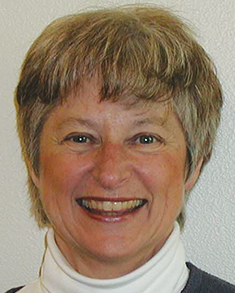Taylor honored for work
on protein kinase A
, professor of chemistry and biochemistry as well as pharmacology at the University of California, San Diego, has won the . Taylor has done pioneering structural studies of protein kinase A, revealing fundamental themes for all protein kinases.

“I was thrilled and deeply honored to receive the news from Natalie Ahn that I had been selected for the 2017 Earl and Thressa Stadtman Award. Although I have never worked in Dr. Earl Stadtman’s lab, I have always considered him to be a close friend and would visit with him every time that I came to NIH. Earl and Thressa are both role models for future generations.”
— Susan S. Taylor
In 1991, the Taylor group solved the structure of the catalytic subunit of PKA, which proved to be a prototype for nearly all other protein kinases. Her structural analyses uncovered detailed insights into the mechanisms of ATP and peptide binding and phosphate transfer as well as the roles of autophosphorylation and open versus closed conformations. These studies were complemented by her structural analyses for the type 1α and type IIβ regulatory subunits of PKA, which revealed how cAMP is recognized by two tandem binding sites linked allosterically.
The Taylor group then solved the structures of PKA holoenzyme. This work showed how the regulatory subunit inhibits the catalytic subunit by forming an R2C2 holoenzyme complex where two regulatory subunits block the activity of each catalytic subunit. Sequential and allosteric binding of cAMP to the regulatory subunit initiates conformational changes that lead to the dissociation of the catalytic activity of the C-subunit, which can then bind its substrate. of the National Heart, Lung and Blood Institute states that this molecular switch is a fundamental regulator of many biological events and defines a mechanism that is adapted in different ways by protein kinases.
Next, the Taylor group began comparing kinases and found another unifying theme: the hydrophobic spine that is present in all active protein kinases. This feature has proven invaluable for inhibitor development. In addition, Taylor collaborated with the late Roger Tsien of UCSD to measure cAMP levels and PKA activity in living cells. From this, she discovered a nuclear export signal in the protein kinase inhibitor.
With the later discovery of proteins known as AKAPs and the mechanism of allosteric activation of the RAF kinase, the Taylor group solidified themselves as leaders in the field. “Her research provides fundamental breakthroughs in our understanding of the catalytic action and regulation of protein kinases,” states Chock.
The Stadtmans, for whom this award was named, exemplified scientific research, mentorship and science statesmanship. of the Yale University Cancer Biology Institute wrote in his letter of support for Taylor’s nomination, “Susan Taylor was a frequent visitor to the Stadtmans’ laboratories at (the National Institutes of Health), and indeed has described herself as ‘a surrogate member of Earl’s family.’”
Taylor received a bachelor’s degree in chemistry from the University of Wisconsin–Madison and a Ph.D. in physiological chemistry from the Johns Hopkins University. She then held two postdoctoral positions at the Medical Research Council Laboratory of 偷拍偷窥 Biology in the U.K. and UCSD.
Among other awards, Taylor has won the ASBMB William C. Rose Award, an American Association for the Advancement of Science fellowship and the Federation of American Societies for Experimental Biology Excellence in Science Award. She also served as president of the ASBMB.
She was elected into the National Academy of Sciences, the National Academy of Medicine, and the American Academy of Arts and Sciences and served on the fellowships advisory panel for the Packard Foundation and the General Motors Cancer Research Foundation Awards Assembly.
Enjoy reading ASBMB Today?
Become a member to receive the print edition four times a year and the digital edition monthly.
Learn moreGet the latest from ASBMB Today
Enter your email address, and we鈥檒l send you a weekly email with recent articles, interviews and more.
Latest in People
People highlights or most popular articles

Unraveling cancer鈥檚 spaghetti proteins
MOSAIC scholar Katie Dunleavy investigates how Aurora kinase A shields oncogene c-MYC from degradation, using cutting-edge techniques to uncover new strategies targeting 鈥渦ndruggable鈥� molecules.

How HCMV hijacks host cells 鈥� and beyond
Ileana Cristea, an ASBMB Breakthroughs webinar speaker, presented her research on how viruses reprogram cell structure and metabolism to enhance infection and how these mechanisms might link viral infections to cancer and other diseases.

Understanding the lipid link to gene expression in the nucleus
Ray Blind, an ASBMB Breakthroughs speaker, presented his research on how lipids and sugars in the cell nucleus are involved in signaling and gene expression and how these pathways could be targeted to identify therapeutics for diseases like cancer.

In memoriam: William S. Sly
He served on the 偷拍偷窥 and 偷拍偷窥 Biology Council in 2005 and 2006 and was an ASBMB member for 35 years.

ASBMB committees welcome new members
Members joined these committees: Education and Professional Development, Maximizing Access, Meetings, 偷拍偷窥, Public Affairs Advisory, Science Outreach and Communication, Student Chapters and Women in Biochemistry and 偷拍偷窥 Biology.

Cadichon honored for academic achievement
She won the State University of New York at Old Westbury鈥檚 Dr. Henry Teoh Award for Outstanding Collegiate Science and Technology Entry Program Graduating Senior, which recognizes exceptional achievement, leadership and promise in a student.

